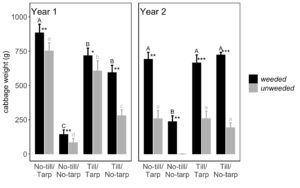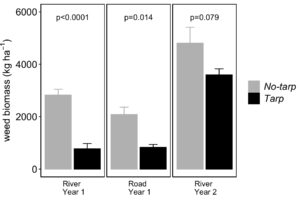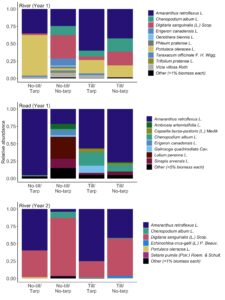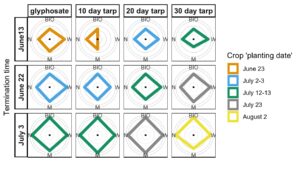Final report for LNE18-371R
Project Information
Cover crop-based no-till production is a promising strategy for farmers to adapt to climate change, improve soil health, and reduce external inputs (e.g. fertilizer or compost). However, effective implementation of this system is challenging in regions where there are limited growing degree days (GDDs) to produce both high biomass cover crops and cash crops, and for small-scale organic farmers who do not have specialized equipment like a roller-crimper to terminate cover crops. This project investigated employing reusable plastic tarps to make cover crop-based no-till a viable strategy for the growing segment of small vegetable farms in northern New England. Tarps eliminate the need for specialized cover crop termination equipment, and we hypothesized that tarps would help overcome weed and nutrient management challenges associated with cover crop-based no-till in northern regions. To study this, we conducted two field experiments in Maine and New Hampshire. The first experiment served as a proof-of-concept for the cover crop-tarp-no-till (CCTNT) system in comparison to tillage-based systems for mid-season cabbage production. Over two seasons in three fields in Maine, cabbage grown in the CCTNT system had equal or greater yields to cabbage grown in tillage-based systems. In a dry summer, cabbage yield from the CCTNT system was 48% higher than a stale seedbed system when weeds were controlled in all systems and 270% higher when weeds were left to grow. These results highlight that the CCTNT provides multiple advantages with respect to weeds and other yield-limiting factors such as soil moisture that are increasingly important in the face of climate change. However, there are tradeoffs associated with the CCTNT practice including the use of GDDs for cover crop production and tarp deployment.
To optimize the CCTNT system and quantify some of these tradeoffs, we conducted a second experiment over two seasons in Maine and New Hampshire. We investigated the effects of tarp application date in late spring/early summer (three dates, 10 days apart) and tarp duration (10, 20, and 30 days) on winter rye-hairy vetch cover crop biomass and N production, cover crop decomposition, soil inorganic N, and weed dynamics. In general, benefits of the CCTNT system increased with both delayed tarp application and longer tarp duration, although at high levels of cover crop biomass (i.e. later termination dates), a longer tarp duration did not contribute to greater weed suppression. The main tradeoff associated with both delayed tarp application and longer tarp duration is delayed crop planting date. The benefits of the CCTNT system must be weighed against the opportunity cost of using GDDs for cover crop production and tarp deployment.
Over the course of this project, we presented our findings to over 1100 farmers and agricultural service providers through conferences, webinars, and field days. Farmers quickly adopted this practice, to the point that some of the farmers with whom we initially worked are now giving presentations on this system and the system is inspiring additional research. Collaborations with other researchers and agricultural service providers led to publication of an extensive, 30 page guide to Tarping in the Northeast, which includes the CCTNT system and other applications of tarping to manage weeds and improve soil health.
This novel system has both agro-ecological and socio-economic knowledge gaps. Our objective is to address both. To assess the ultimate adoptability of the CCTNT practice, we will first investigate the extent to which it provides increased ecosystem services, specifically yield, weed suppression, and soil health, as well as the costs of implementing the system. With this information, we will assess whether farmers are willing to adopt this system and their valuation of individual components/attributes of the system (e.g. increased soil health vs. the use of plastic) using a discrete choice experiment that will guide outreach efforts and future research.
Cover crops and no-till are management practices that can improve soil health, but their implementation in vegetable production systems remains limited, particularly in cooler climates like New England with shorter growing seasons. While cover crop use is increasing, most vegetable farmers terminate them before peak biomass because of challenges associated with residue incorporation and nutrient immobilization. This project aimed to address the limitations of no-till and cover cropping in a scale-appropriate way for vegetable farmers in the Northeast by using reusable plastic tarps. Small-scale vegetable farms represent a critical part of the agricultural landscape in the Northeast. There were 458 certified organic vegetable farms in the six New England states and 4,126 small vegetable farms (growing 0.1-4.9 acres of vegetables) in 2017.
Tarps are an increasingly popular tool for many small-scale growers and are mostly used to augment stale seedbedding with bare soil or in no-till systems with deep (e.g. 2-5 inches) compost mulch. Cover crops present an alternative to deep compost to facilitate no-till production by producing an in situ mulch that can suppress weeds and retain moisture. Additionally, legume cover crops can provide a source of biologically fixed nitrogen while scavenging cover crops like rye can capture nutrients before they enter waterways. We found that tarps are a critical tool to harness the benefits of cover crop-based no-till because they facilitate flexible timing of cover crop termination while providing additional weed suppression and possible benefits of increased N mineralization. For short, we call this system CCTNT (cover crop-tarp-no-till).
Cooperators
- (Educator)
- (Researcher)
- (Researcher)
Research
- Solarizing tarps improve the performance of high residue organic no-till vegetable production through effective cover crop termination, enhanced weed suppression, and improved nutrient availability and soil health.
- Benefits of tarping with respect to weed suppression and nutrient availability increase with longer tarp duration, but cover crops are terminated and weeds are mostly suppressed in as little as one week.
- Solarizing tarps and CCTNT systems will alleviate the economic and environmental constraints that currently limit small-scale farmer adoption of cover crops and no-till practices.
Overview
Over the course of the project, we conducted two replicated field experiments in Maine and New Hampshire, as well as unreplicated on-farm trials with participating farmers on the cover crop, tarp, no-till (CCTNT) system. The first field experiment was a proof-of-concept systems experiment based on preliminary data from a field trial at UNH in 2016. The preliminary trial and subsequent multi-year field experiment investigated the use of tarps to terminate rye-vetch cover crops for no-till cabbage production. The second experiment was intended to refine the CCTNT system and probe the tradeoffs associated with cover crop termination timing (i.e. termination date) and tarp duration (10, 20, 30 days). In addition to black tarps, we included a glyphosate control at both site years and a roll-crimp treatment at one site year. The response variables (and hence, tradeoffs) we measured included cover crop biomass and nitrogen, weed suppression and community dynamics, mulch provisioning, cover crop decomposition, and inorganic soil N. We contextualized these tradeoffs within the framework of planting dates resulting from these treatment combinations. Unreplicated on-farm experiments were designed by farmers and included different types of tarps, cover crops, and cash crops for variable durations.
CCTNT Proof-of-concept experiment
Over two years in three fields in Turner, Maine, we implemented a proof-of-concept experiment for the CCTNT system using cabbage as a model crop. We chose cabbage because it is typically transplanted, harvested only once, and sensitive to hot temperatures, making it a good candidate for the CCTNT system that might reduce soil temperatures. Additionally, short-season cabbage varieties allow for later planting dates that are amenable to the CCTNT system. In each field, all plots were planted to a winter-rye hairy vetch biculture in mid-to-late September. The following early June, a factorial combination of tarp (tarp vs. no-tarp) and tillage (till vs. no-till) treatments (four total) were applied prior to cabbage transplanting in early July. Cover crops were either mowed with a sickle bar mower or rolled with a disengaged rototiller [No-till/tarp (CCTNT) only]. Tilled plots were tilled with a tractor-mounted rototiller. Four mil low density polyethylene (LDPE) tarps were applied to tarp treatments. No-tarp treatments received additional weed management at the same time tarps were removed, prior to cabbage transplanting. No-till/no-tarp plots were mowed with a lawnmower, and Till/no-tarp plots were lightly scuffled with a hoe to simulate a stale-seedbed practice.
Cabbages were transplanted by creating a hole with a stand-up tree dibbler and then dropping in a cabbage start (72 plug tray). Main treatment plots were divided into weeded and unweeded subplots to measure the effect of weeds on cabbage yields as well as the effect of treatments on weed abundance and community. Weeded subplots were hand-weeded throughout the season. Cabbage yield and weed biomass were measured at the end of August.
CCTNT Optimization experiment
Over two seasons in Turner, Maine and Durham, NH, we implemented a CCTNT optimization experiment that did not include a model (cash) crop. We seeded a winter rye-hairy vetch biculture in mid-to-late September. The following year, treatments were applied in a factorial combination of termination date (three dates, ten days apart), and termination method (10 day tarp, 20 day tarp, 30 day tarp, glyphosate, and roller crimper (UNH only)). The resulting combination of termination dates and termination methods spanned a range of (hypothetical) planting dates across over a month. In late spring/early summer, we quantified cover crop biomass and nitrogen content, C:N ratio, and rye-vetch ratio on each termination date. On the hypothetical planting dates, we measured soil inorganic N, followed by measurements three weeks later of the amount of mulch remaining, weed biomass and community composition. Additionally, we deployed litter bags with cover crop residue from the respective termination date to determine differences in cover crop decomposition based on termination treatment method.
On-farm experiments
Five on-farm experiments with farmer-led treatments included: cauliflower grown in three treatments including tilled soil with black plastic, tilled soil without black plastic, and no-till with an oat cover crop terminated with a tarp; broccoli grown in tilled soil vs. no-till in rye terminated with a tarp; acorn squash grown in sod terminated with a tarp that was either tilled or no-till; no-till cabbages grown in a rye clover cover crop terminated with a tarp; and mixed vegetables grown either in tilled soil or no-till rye terminated with a tarp.
CCTNT Proof-of-concept experiment
Complete results of our experiment are in press in HortScience. Importantly, the CCTNT system led to either equal or greater cabbage yields compared to a more traditional stale seedbed (Till/no-tarp) treatment (Figure 1). The first year of the experiment, during which July was substantially drier than average, the CCTNT system outyielded the Till/no-tarp system by nearly 50% in the weeded subplots and 270% in the unweeded subplots. We speculate that these conditions exemplify the type of dry conditions during which CCTNT provides an advantage because soil moisture is regulated by the mulch remaining on the soil surface as well as the uninterrupted capillary rise from no-till.
Weed dynamics in this experiment showed that tarping can be a very effective method for reducing weed biomass that is enduring (i.e. weed biomass was measured at cabbage harvest) (Figure 2). However, tarping, like tillage, appears to select for certain weeds while suppressing most others (Figure 3). This highlights the need to understand the weed seedbank density (how many weeds present) and composition (which weeds are present) before deploying the CCTNT system. This system should be viewed as part of an integrated weed management system, not a sole practice.



CCTNT Optimization experiment
Over two seasons in Turner, Maine and Durham, NH, we implemented a CCTNT optimization experiment that did not include a model (cash) crop. We seeded a winter rye-hairy vetch biculture in mid-to-late September. The following year, treatments were applied in a factorial combination of termination date (three dates, ten days apart), and termination method (10 day tarp, 20 day tarp, 30 day tarp, glyphosate, and roller crimper (UNH only)). The resulting combination of termination dates and termination methods spanned a range of (hypothetical) planting dates across over a month. In late spring/early summer, we quantified cover crop biomass and nitrogen content, C:N ratio, and rye-vetch ratio on each termination date. On the hypothetical planting dates, we measured soil inorganic N, followed by measurements three weeks later of the amount of mulch remaining, weed biomass and community composition. Additionally, we deployed litter bags with cover crop residue from the respective termination date to determine differences in cover crop decomposition based on termination treatment method.


The CCTNT system is a promising adaptive strategy for small-scale farmers in the face of climate change. In situ mulch from cover crops can provide moisture conservation and weed suppression. Terminating cover crops in this way does not require specialized tools and cover crops can be allowed to grow to peak biomass without interfering with equipment. This is a significant change from past cover cropping strategies, which relied on mowing and incorporation. Additionally, growing legume cover crops like hairy vetch can contribute to on-farm nutrient cycling, reducing the need for external fertilizer. While many small-scale farms have transitioned to no-till through heavy use of compost, the CCTNT system provides an opportunity to reduce tillage and transition to no-till without importing nutrients at excessive levels.
Context matters for implementing the CCTNT system, and both soil health and weed seedbank dynamics strongly influence success. High clay and compacted soils as well as soils with high seedbank or perennial budbank densities are likely not good candidates for implementing the CCTNT system. Integrated efforts to improved soil health and reduce the seed and budbanks may be necessary. While our system focused on overwintering cover crops, the CCTNT system could be implemented in other sequences, providing rotational complexity that can contribute to an integrated weed management program.
Education & Outreach Activities and Participation Summary
Educational activities:
Participation Summary:
Presentations and webinars:
Lounsbury, Natalie and Jason Lilley. Presentation: Small-scale cover crop management: highlighting innovation and BMPs. Northeast Cover Crop Council Annual Meeting, State College, PA. November 15, 2018.
Approximately 30 people (mostly ag service providers) in attendance.
Lounsbury, Natalie. Presentation: Tarps for cover crop based no-till. Vermont Vegetable and Berry Growers’workshop on tarping and mulching. Fairlee, VT. January 22, 2019.
Approximately 150 farmers and a few service providers in attendance.*
*in attendance was farmer Ryan Fitzbeauchamp, who subsequently adopted the CCTNT practice and has given numerous talks on it including a MOFGA webinar No-till production on heavy cover crop residue (December 9, 2021), and the NEVFC (December 13, 2021).
Lounsbury, Natalie and advisory committee member Jeremy Delisle. Field day: Reduced tillage practices and equipment demonstration (in conjunction with NRCS and conservation districts). Woodman Farm, Durham, NH (UNH). June 26, 2019.
An early afternoon workshop for service providers (NRCS) had 12 attendees. A later afternoon workshop for farmers also had 12 attendees.
Warren, Nicholas. Field day for New Hampshire Extension specialists. Woodman Farm, Durham, NH (UNH). July 25, 2019.
26 people in attendance.
Lilley, Jason. Field Day and Equipment demonstration. Bumbleroot Farm (advisory committee member) in Windham, ME. August 29, 2019.
15 farmers in attendance.
Lounsbury, Natalie and Daniel Mays (advisory committee member). Presentations and discussion: Cover cropping on low-acreage: strategies for maximizing agroecological benefits. MOFGA's Farmer to Farmer Conference, Northport, ME November 3, 2019.
50 farmers in attendance.
Lounsbury, Natalie. Presentation: Tarping cover crops for organic no-till. New England Vegetable and Fruit Conference. Manchester, NH. December 10, 2019.
90 farmers in attendance.
Lounsbury, Natalie. Webinar: Cover crops, tarping, and weeds. University of New Hampshire Integrated Pest Management webinar series. February 14, 2020.
In addition to attendees, it has had 195 views online.
Lounsbury, Natalie. Webinar: No-till and cover crops in vegetable systems. University of Vermont Cover Crops and Reduced Tillage webinar series. April 6, 2020.
In addition to attendees, it has 200 views online.
Lounsbury, Natalie. Webinar:Tarping and cover crops for organic rotational no-till. Washington State University on February 25, 2021.
There were 192 live attendees and 70 subsequent registrations to view the recording.
Natalie Lounsbury. Online conference: Research update: tradeoffs of cover crop termination date and method for organic no-till. New England Vegetable and Fruit Conference. December 13, 2021.
260 attendees (primarily farmers, but some ag service providers)*
*In the same session, farmers Ryan Fitzbeauchamp and Daniel Mays presented their farms’ use of the CCTNT system
Upcoming:
Lounsbury, Natalie. Online conference: Cover crop-based no-till and tarping for small farms. Empire State Producers Expo. March 8, 2022.
Lounsbury, Natalie. Online conference: Using precious growing degree days: tradeoffs between cover crop growth, termination date, and tarping duration in small-scale organic no-till. Northeast Cover Crop Council Annual Meeting. March 11, 2022.
Extension publications:
Lounsbury, N., S. Birthisel, J. Lilley, and R. Maher. Tarping in the Northeast: A Guide for Small Farms. University of Maine Cooperative Extension Bulletin # 1075 https://extension.umaine.edu/publications/1075e/
This 30 page guide plus six case studies covers how tarps work, the logistics of tarping, and practice sections for specific uses of tarps on the farm. An in-depth discussion of high-residue cover crops for no-till production with photos is included in the practice sections. Case studies include one farmer collaborator and a farmer who started using the high-residue no-till system after learning about our research. Currently only available online, but will be formatted for a pdf version that I will add as a product when it is available.
Peer-reviewed publications:
Lounsbury, N., N. Warren, S. Wolfe, R. Smith. 2020. Investigating tarps to facilitate organic no-till cabbage production with high-residue cover crops. Renewable Agriculture and Food Systems. 35:227-233. https://doi.org/10.1017/S1742170518000509
Lounsbury, N. B. Lounsbury, N. Warren, R. Smith. (in press). Tarping cover crops facilitates organic no-till cabbage production and suppresses weeds. HortScience. (will be open access).
Dissertation:
Lounsbury, N. 2021. Cover crop-based no-till for small farms: tradeoffs of termination time, method, and ecosystem services. Dissertation, University of New Hampshire.
Learning Outcomes
A farmer sent an email asking about transplanting tools to use in this system. After a discussing of what might work, he replied "Seeing your presentation a couple years ago was a real inspiration to try this different growing method. After managing our farm for 8 years with intensive tillage and seeing problems proliferate, it's delightful for me to be able to grow crops in this way with excellent weed suppression, soil coverage, and reduced tillage." This system provides a way for farmers to integrate practices that they know are "good" for soil, but are sometimes hard to integrate (i.e. cover crops and reduced tillage), largely because of weeds.
Project Outcomes
Information Products
- Investigating tarps to facilitate organic no-till cabbage production with high-residue cover crops (Peer-reviewed Journal Article)
- Tarping in the Northeast: A Guide for Small Farms (Manual/Guide)